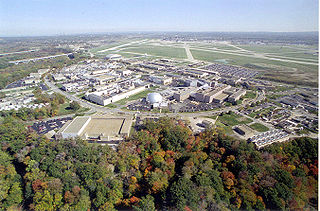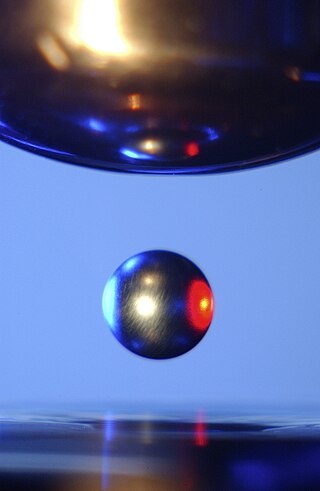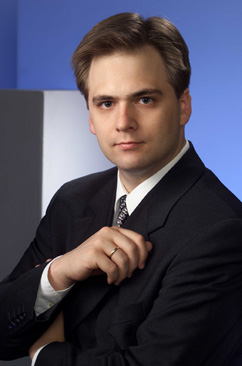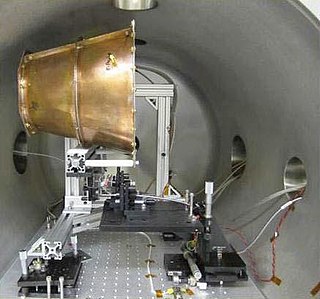
The Gravity Research Foundation is an organization established in 1948 by businessman Roger Babson to find ways to implement gravitational shielding. Over time, the foundation turned away from trying to block gravity and began trying to understand it. It holds an annual contest rewarding essays by scientific researchers on gravity-related topics. The contest, which awards prizes of up to $4,000, has been won by at least six people who later won the Nobel Prize in physics.
The Biefeld–Brown effect is an electrical phenomenon that produces an ionic wind that transfers its momentum to surrounding neutral particles. It describes a force observed on an asymmetric capacitor when high voltage is applied to the capacitor's electrodes. Once suitably charged up to high DC potentials, a thrust at the negative terminal, pushing it away from the positive terminal, is generated. The effect was named by inventor Thomas Townsend Brown who claimed that he did a series of experiments with professor of astronomy Paul Alfred Biefeld, a former teacher of Brown whom Brown claimed was his mentor and co-experimenter at Denison University in Ohio.
Thomas Townsend Brown was an American inventor whose research into odd electrical effects led him to believe he had discovered a connection between strong electric fields and gravity, a type of antigravity effect. Instead of being an antigravity force, what Brown observed has generally been attributed to electrohydrodynamics, the movement of charged particles that transfers their momentum to surrounding neutral particles in air, also called "ionic drift" or "ionic wind". For most of Brown's life he attempted to develop devices based on his ideas, trying to promote them for use by industry and the military. The phenomena came to be called the "Biefeld–Brown effect" and "electrogravitics".
The Breakthrough Propulsion Physics Project (BPP) was a research project funded by NASA from 1996 to 2002 to study various proposals for revolutionary methods of spacecraft propulsion that would require breakthroughs in physics before they could be realized. The project ended in 2002, when the Advanced Space Transportation Program was reorganized and all speculative research was cancelled. During its six years of operational funding, this program received a total investment of $1.2 million.

Anti-gravity is a hypothetical phenomenon of creating a place or object that is free from the force of gravity. It does not refer to either the lack of weight under gravity experienced in free fall or orbit, or to balancing the force of gravity with some other force, such as electromagnetism and aerodynamic lift. Anti-gravity is a recurring concept in science fiction. Examples are the gravity blocking substance "Cavorite" in H. G. Wells's The First Men in the Moon and the Spindizzy machines in James Blish's Cities in Flight.

NASA John H. Glenn Research Center at Lewis Field is a NASA center within the cities of Brook Park and Cleveland between Cleveland Hopkins International Airport and the Rocky River Reservation of Cleveland Metroparks, with a subsidiary facility in Sandusky, Ohio. Its director is James A. Kenyon. Glenn Research Center is one of ten major NASA facilities, whose primary mission is to develop science and technology for use in aeronautics and space. As of May 2012, it employed about 1,650 civil servants and 1,850 support contractors on or near its site.

Electrostatic levitation is the process of using an electric field to levitate a charged object and counteract the effects of gravity. It was used, for instance, in Robert Millikan's oil drop experiment and is used to suspend the gyroscopes in Gravity Probe B during launch.
Dr. Paul Alfred Biefeld was a German-American electrical engineer, astronomer and teacher.
An ion-propelled aircraft or ionocraft is an aircraft that uses electrohydrodynamics (EHD) to provide lift or thrust in the air without requiring combustion or moving parts. Current designs do not produce sufficient thrust for manned flight or useful loads.

Electrohydrodynamics (EHD), also known as electro-fluid-dynamics (EFD) or electrokinetics, is the study of the dynamics of electrically charged fluids. It is the study of the motions of ionized particles or molecules and their interactions with electric fields and the surrounding fluid. The term may be considered to be synonymous with the rather elaborate electrostrictive hydrodynamics. ESHD covers the following types of particle and fluid transport mechanisms: electrophoresis, electrokinesis, dielectrophoresis, electro-osmosis, and electrorotation. In general, the phenomena relate to the direct conversion of electrical energy into kinetic energy, and vice versa.

Ion wind, ionic wind, corona wind or electric wind is the airflow of charged particles induced by electrostatic forces linked to corona discharge arising at the tips of some sharp conductors subjected to high voltage relative to ground. Ion wind is an electrohydrodynamic phenomenon. Ion wind generators can also be considered electrohydrodynamic thrusters.
The term gravitational shielding refers to a hypothetical process of shielding an object from the influence of a gravitational field. Such processes, if they existed, would have the effect of reducing the weight of an object. The shape of the shielded region would be similar to a shadow from the gravitational shield. For example, the shape of the shielded region above a disk would be conical. The height of the cone's apex above the disk would vary directly with the height of the shielding disk above the Earth. Experimental evidence to date indicates that no such effect exists. Gravitational shielding is considered to be a violation of the equivalence principle and therefore inconsistent with both Newtonian theory and general relativity.
Ning Li was a Chinese American scientist. Born in Shandong, she graduated from the Department of Physics of Peking University, and in 1983 she emigrated with her family from China to the United States. She is known for her physics and anti-gravity research. In the 1990s, Li worked as a research scientist at the Center for Space Plasma and Aeronomic Research, University of Alabama in Huntsville. In 1999, she left the university to form a company, AC Gravity LLC, to continue anti-gravity research.
A reactionless drive is a hypothetical device producing motion without the exhaust of a propellant. A propellantless drive is not necessarily reactionless when it constitutes an open system interacting with external fields; but a reactionless drive is a particular case of a propellantless drive that is a closed system, presumably in contradiction with the law of conservation of momentum. Reactionless drives are often considered similar to a perpetual motion machine. The name comes from Newton's third law, often expressed as: "For every action, there is an equal and opposite reaction."

Martin Tajmar is a physicist and professor for Space Systems at the Dresden University of Technology. He has research interests in advanced space propulsion systems, FEEP thrusters, breakthrough propulsion physics and possible connections between gravity and superconductivity.

The EmDrive is a concept for a thruster for spacecraft, first written about in 2001. It is purported to generate thrust by reflecting microwaves inside the device, in a way that would violate the law of conservation of momentum and other laws of physics. The concept has at times been referred to as a resonant cavity thruster.
Advanced Space Propulsion Investigation Committee (ASPIC) was a research group of specialists, including Y.Minami, and T.Musha, which was organized under the Japan Society for Aeronautical and Space Sciences in 1994. Its purpose was to study various non-chemical space propulsion systems instead of the conventional rocket for the use of space missions to near-Earth, the Moon, and the outer solar system, including plasma propulsion, laser propulsion, nuclear propulsion, solar sail and field propulsion systems which utilize a strain on space, zero-point energy in a vacuum, electro-gravitic effect, non-Newtonian gravitic effect predicted by Einstein's general theory of relativity, and the terrestrial magnetism. The research report was published by the Japan Society for Aeronautical and Space Sciences in March 1996.
Field propulsion is the concept of spacecraft propulsion where no propellant is necessary but instead momentum of the spacecraft is changed by an interaction of the spacecraft with external force fields, such as gravitational and magnetic fields from stars and planets. Proposed drives that use field propulsion are often called a reactionless or propellantless drive.
American interest in "gravity control propulsion research" intensified during the early 1950s. Literature from that period used the terms anti-gravity, anti-gravitation, baricentric, counterbary, electrogravitics (eGrav), G-projects, gravitics, gravity control, and gravity propulsion. Their publicized goals were to discover and develop technologies and theories for the manipulation of gravity or gravity-like fields for propulsion. Although general relativity theory appeared to prohibit anti-gravity propulsion, several programs were funded to develop it through gravitation research from 1955 to 1974. The names of many contributors to general relativity and those of the golden age of general relativity have appeared among documents about the institutions that had served as the theoretical research components of those programs. Since its emergence in the 1950s, the existence of the related gravity control propulsion research has not been a subject of controversy for aerospace writers, critics, and conspiracy theory advocates alike, but their rationale, effectiveness, and longevity have been the objects of contested views.
The EAD Airframe Version 2, or V2, is a small American unmanned aircraft. It has been described as 'solid state', as there are no moving parts in the propulsion system; all thrust is powered by the phenomenon known as ion wind. It is being developed at the Massachusetts Institute of Technology (MIT) Department of Aeronautics and Astronautics by engineer Steven Barrett and others.







